Human development for the MCAT encompasses the physical, cognitive, social, and emotional growth processes occurring from infancy through adulthood, driven by biological, psychological, and environmental factors. It explores foundational theories, such as Erikson’s psychosocial stages, Piaget’s cognitive development, and attachment theories, which describe how individuals progress in reasoning, self-identity, and relationships.
Learning Objectives
In studying "Human Development" for the MCAT, you should learn to understand the stages of physical, cognitive, and social development from infancy through adulthood. Analyze key developmental theories, such as Piaget’s stages of cognitive development, Erikson’s psychosocial stages, and Kohlberg’s stages of moral reasoning. Evaluate the impact of biological, environmental, and cultural factors on development. Additionally, explore how early childhood experiences influence lifelong behavior and mental health. Apply your understanding of human development to interpret research findings, behavioral patterns, and case scenarios in MCAT practice passages, focusing on developmental milestones, critical periods, and variations across individuals and populations.
1. Biological and Environmental Influences on Development
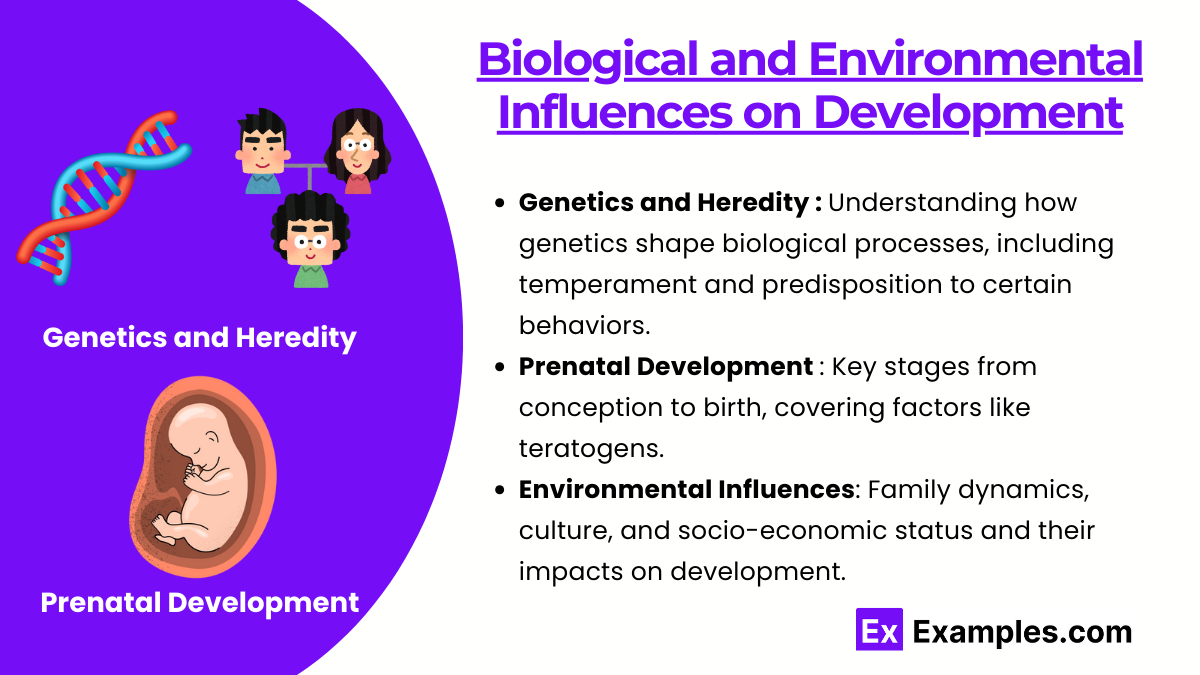
Genetics and Heredity: Understanding how genetics shape biological processes, including temperament and predisposition to certain behaviors.
Prenatal Development: Key stages from conception to birth, covering factors like teratogens (substances harmful to fetal development, e.g., alcohol or drugs).
Environmental Influences: Family dynamics, culture, and socio-economic status and their impacts on development.
2. Theories of Human Development
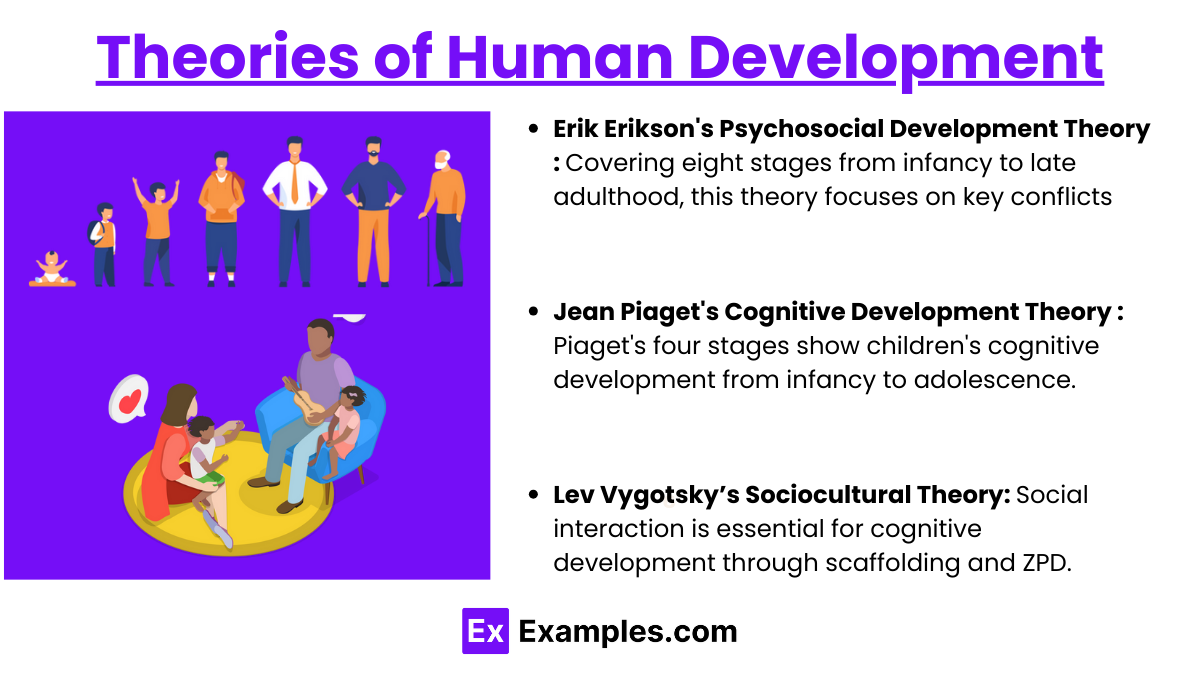
Erik Erikson's Psychosocial Development Theory: Covering eight stages from infancy to late adulthood, this theory focuses on key conflicts (e.g., trust vs. mistrust, autonomy vs. shame) that individuals must resolve to achieve healthy development.
Jean Piaget's Cognitive Development Theory: Piaget describes four stages—sensorimotor, preoperational, concrete operational, and formal operational—that outline how children's thinking processes evolve as they age.
Lev Vygotsky’s Sociocultural Theory: Emphasizes social interaction’s crucial role in cognitive development, introducing concepts like the Zone of Proximal Development and scaffolding.
Lawrence Kohlberg's Moral Development Theory: Considers how people progress through moral reasoning stages, from pre-conventional to conventional and post-conventional morality, with implications for ethical decision-making.
3. Personality Development and Identity
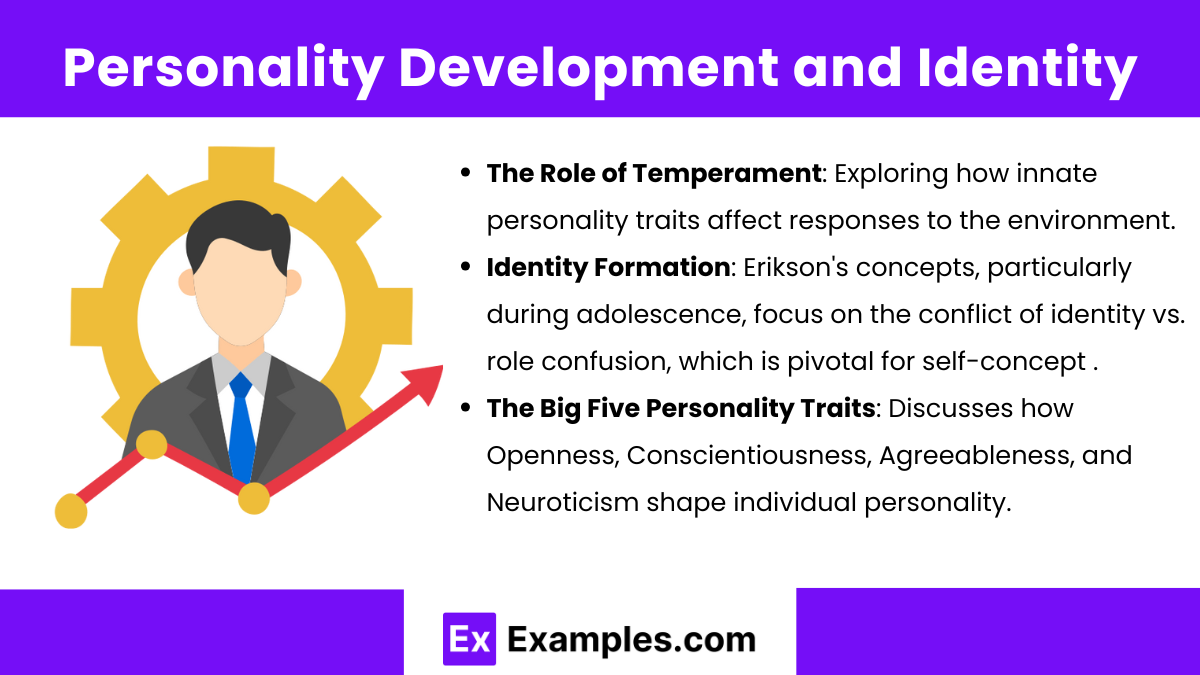
The Role of Temperament: Exploring how innate personality traits affect responses to the environment.
Identity Formation: Erikson's concepts, particularly during adolescence, focus on the conflict of identity vs. role confusion, which is pivotal for self-concept and personal values.
The Big Five Personality Traits: Discusses how Openness, Conscientiousness, Extraversion, Agreeableness, and Neuroticism shape individual personality.
4. Language and Cognitive Development
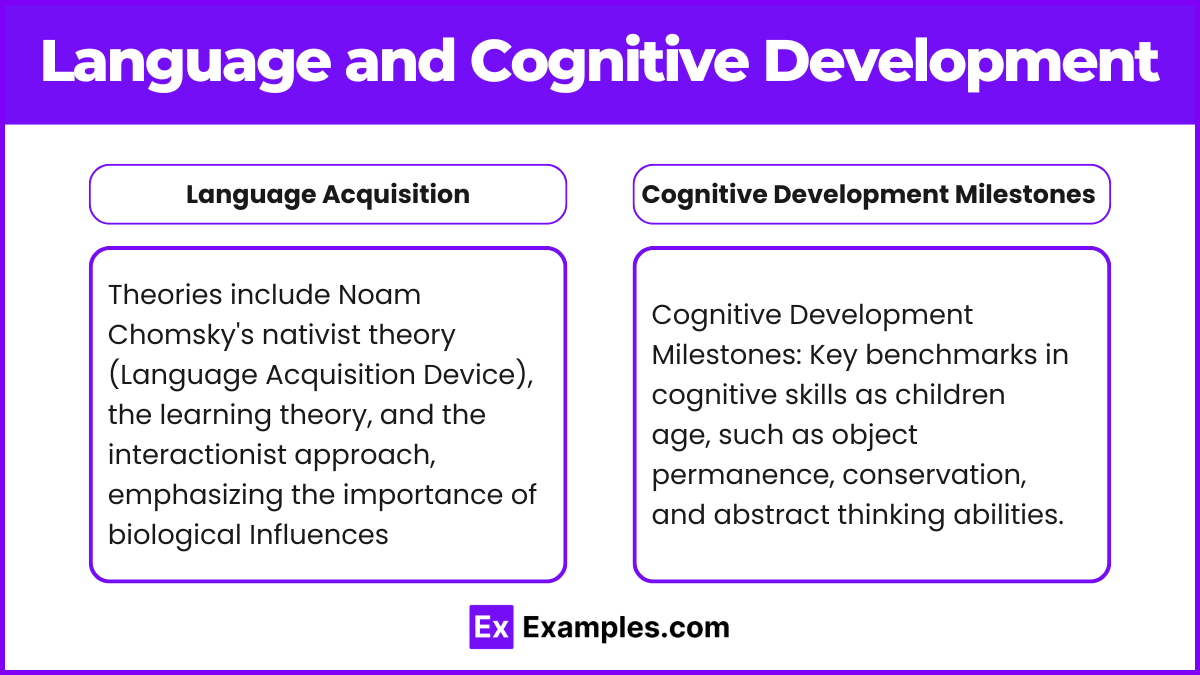
Language Acquisition: Theories include Noam Chomsky's nativist theory (Language Acquisition Device), the learning theory, and the interactionist approach, emphasizing the importance of biological and social influences.
Cognitive Development Milestones: Key benchmarks in cognitive skills as children age, such as object permanence, conservation, and abstract thinking abilities.
5. Psychosocial Development and Life Transitions
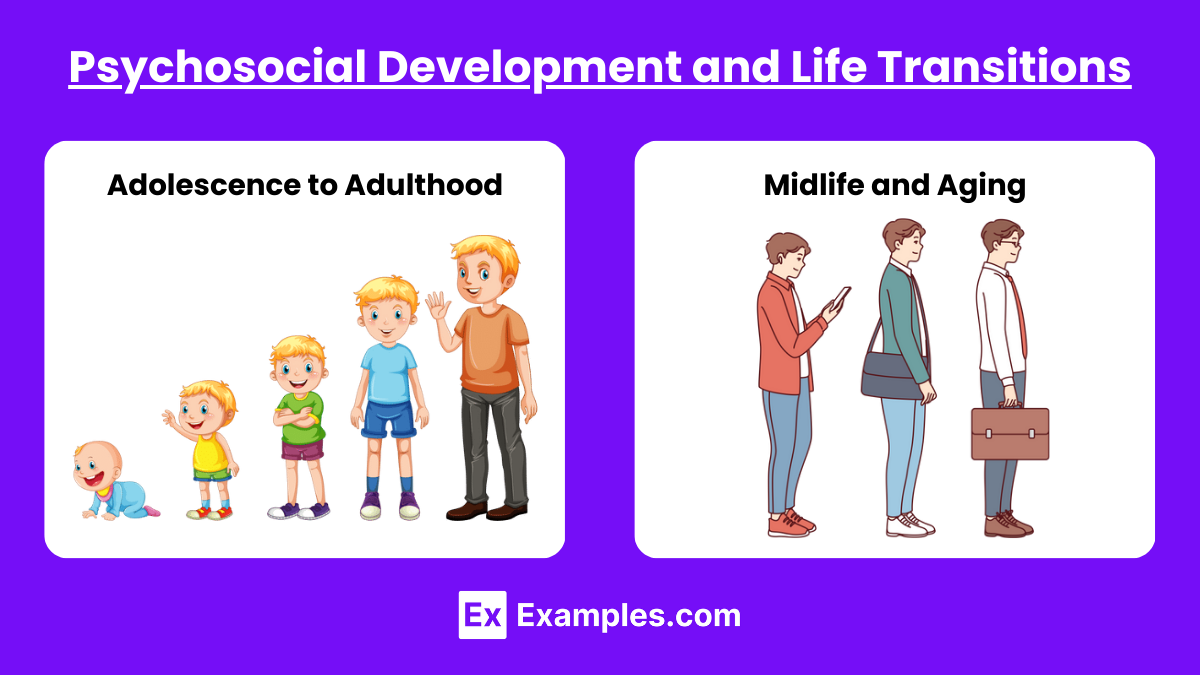
Adolescence to Adulthood: Understanding role transitions, including independence, career establishment, and social expectations.
Midlife and Aging: Life changes in middle age (e.g., empty nest syndrome) and cognitive changes in later life (e.g., memory and processing speed changes).
6. Social and Cultural Influences on Development
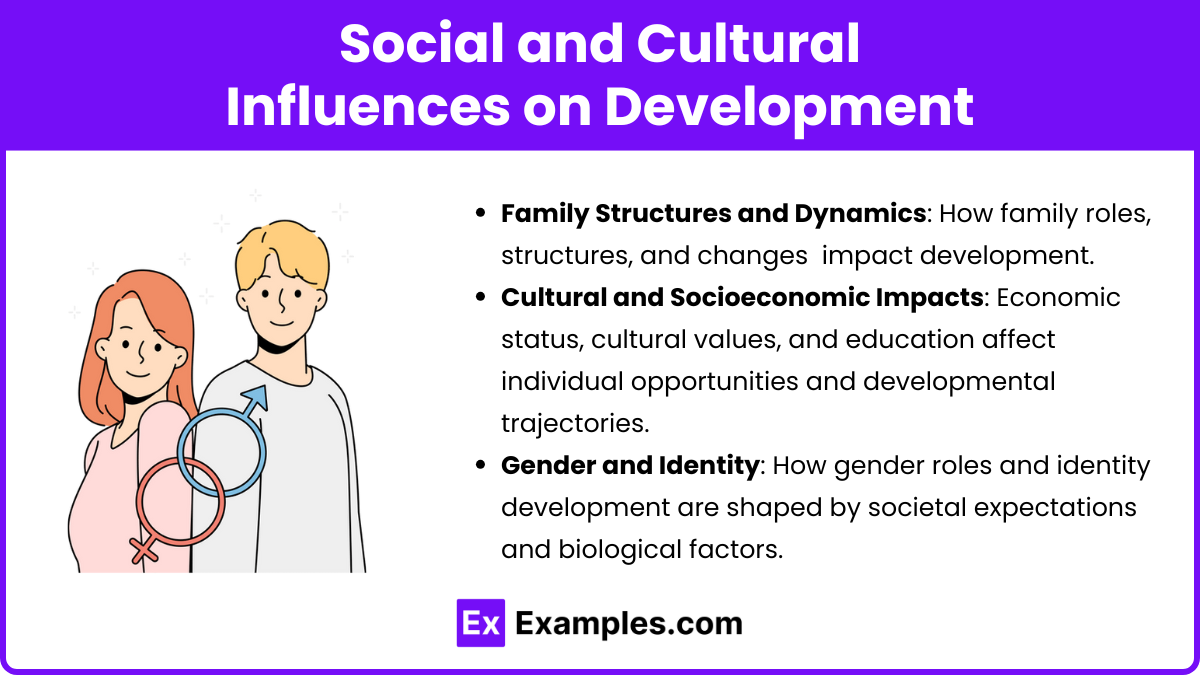
Family Structures and Dynamics: How family roles, structures, and changes (like divorce or remarriage) impact development.
Cultural and Socioeconomic Impacts: Economic status, cultural values, and education affect individual opportunities and developmental trajectories.
Gender and Identity: How gender roles and identity development are shaped by societal expectations and biological factors.
Examples
Example 1: Attachment in Infancy
Attachment theory, pioneered by John Bowlby and Mary Ainsworth, explains how early relationships, especially with primary caregivers, shape future emotional and social behaviors. For example, a secure attachment fosters trust and emotional resilience, while insecure attachments may lead to challenges in social relationships and self-esteem. This theory underscores the significance of early bonds on long-term psychological health.
Example 2: Cognitive Development in Childhood
Jean Piaget's stages of cognitive development, particularly the preoperational and concrete operational stages, highlight how children’s thinking evolves from egocentric, symbolic thought to more logical and concrete reasoning. For instance, during the concrete operational stage, children begin to understand conservation—the idea that quantity remains the same despite changes in shape or arrangement—illustrating cognitive maturation.
Example 3: Identity Formation in Adolescence
Erikson's theory of psychosocial development emphasizes the "identity vs. role confusion" stage, critical in adolescence. During this period, individuals explore personal values, beliefs, and goals, forming a distinct sense of identity. Successfully navigating this stage contributes to a stable self-concept, while unresolved conflicts can lead to uncertainty about one’s role in society and future direction.
Example 4: Moral Development in Adolescence and Adulthood
Lawrence Kohlberg’s stages of moral development describe how individuals evolve in ethical reasoning. For example, in the conventional stage, adolescents and adults make moral decisions based on societal rules and expectations. As they progress to the post-conventional stage, some may base moral decisions on universal principles of justice, even if these conflict with laws, showing higher-level moral reasoning.
Example 5: Social Changes in Adulthood and Aging
Erikson’s later stages, like "generativity vs. stagnation" in middle adulthood and "integrity vs. despair" in late adulthood, describe the need for purpose and reflection. For instance, middle-aged adults often seek to contribute to society through work, family, or community roles, while older adults reflect on life achievements and challenges, seeking meaning in their lived experiences.
Practice Questions
Question 1
Which of the following statements best reflects the concept of "object permanence" as described by Piaget's theory of cognitive development?
A) An infant becomes distressed when separated from their primary caregiver.
B) A child realizes that pouring water from a tall, thin glass into a short, wide glass does not change the amount of water.
C) An infant understands that an object continues to exist even when it is out of sight.
D) A teenager develops the ability to think about hypothetical situations and abstract ideas.
Answer: C) An infant understands that an object continues to exist even when it is out of sight.
Explanation: Object permanence is a key milestone in Piaget’s sensorimotor stage of cognitive development, typically emerging around 8-12 months of age. It refers to the understanding that objects and people continue to exist even when they are no longer visible. This concept is crucial in early cognitive development, as it underpins the infant’s ability to engage with the world meaningfully. Options A, B, and D represent different aspects of development, such as attachment, conservation, and abstract reasoning, but only option C correctly describes object permanence.
Question 2
According to Erikson's stages of psychosocial development, which of the following conflicts is most relevant for adolescents?
A) Trust vs. mistrust
B) Initiative vs. guilt
C) Identity vs. role confusion
D) Generativity vs. stagnation
Answer: C) Identity vs. role confusion
Explanation: Erikson’s theory of psychosocial development includes the stage of "identity vs. role confusion," which is most relevant during adolescence. In this stage, individuals face the task of developing a personal identity and sense of self. Successfully resolving this conflict leads to a strong identity, whereas failure may result in uncertainty about future roles and self-perception. The other stages listed are relevant to different age groups: "trust vs. mistrust" pertains to infancy, "initiative vs. guilt" to early childhood, and "generativity vs. stagnation" to middle adulthood.
Question 3
According to Kohlberg's theory of moral development, which of the following is a characteristic of post-conventional moral reasoning?
A) Following rules to avoid punishment and gain rewards.
B) Behaving in a way that is approved by social norms and conventions.
C) Making decisions based on universal ethical principles, even if they conflict with societal laws.
D) Complying with rules to maintain law and order within society.
Answer: C) Making decisions based on universal ethical principles, even if they conflict with societal laws.
Explanation: In Kohlberg's theory, post-conventional moral reasoning is characterized by adherence to universal ethical principles that may supersede societal rules or laws. This stage is where individuals make moral decisions based on abstract principles like justice, equality, and human rights, and they may question rules if they believe them to be unjust. Options A and B represent pre-conventional and conventional levels, where moral decisions are based on avoiding punishment, seeking rewards, or conforming to social expectations. Option D represents conventional moral reasoning, emphasizing rule-following for social stability, not universal ethics.


